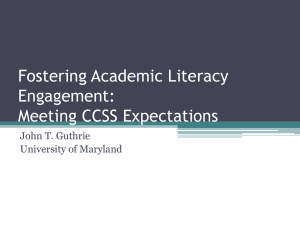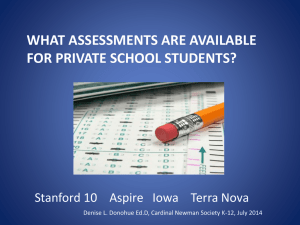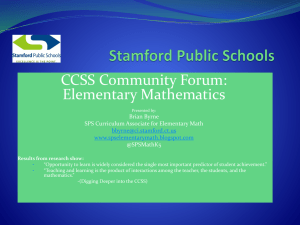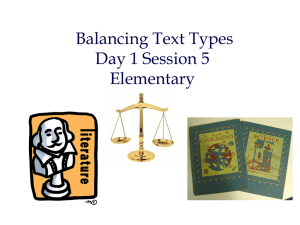power point slide presentation - CORI
advertisement
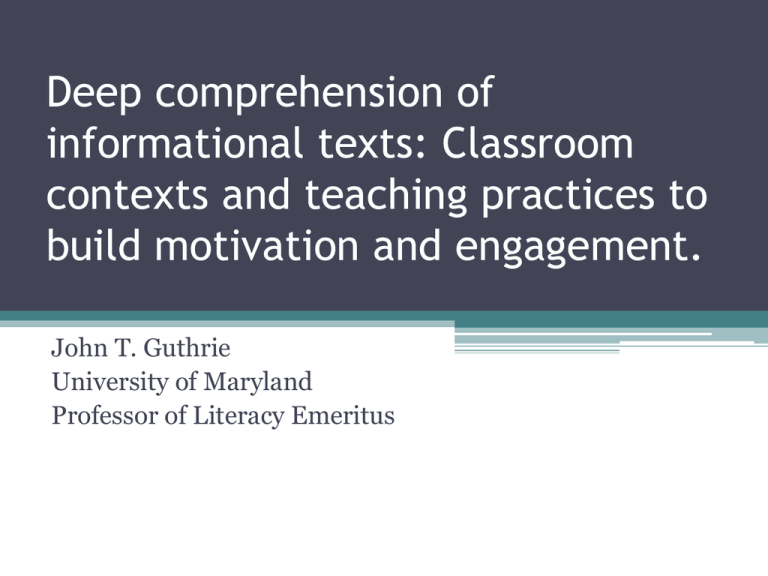
Deep comprehension of informational texts: Classroom contexts and teaching practices to build motivation and engagement. John T. Guthrie University of Maryland Professor of Literacy Emeritus Today’s outline 1. Is there a motivation challenge in the CCSS? 2. What are students’ motivations for reading information text? 3. How do motivations relate to proficiency, growth and use of reading skill? 4. How can teachers increase long term motivation? 5. Is the benefit of motivation support worth the cost of time, effort, money? 6. How can motivation be connected to a CCSS Is there a motivation challenge in the CCSS? • Cognitive--▫ ▫ ▫ ▫ Complex texts Disciplines of science, history, literature Close reading; knowledge building Reasoning, integration, vocabulary • Motivation and engagement ▫ Extensive reading ▫ Confidence, interest, values, peers Challenges Reading in South Africa—lowest of 70 countries • Compared to world SA has problem; • Compared to Asia, US has a problem; • Compared to CCSS we all have a problem Motivation and Engagement How much instruction for close reading? • How many 30 minute lessons? How many 30 minute sessions? • How much volume for integrations across texts? Number of lessons? Number of sessions? • Will students do the reading? Top 20 percent, yes. (SA example St. Charles College) Today’s outline 1. Is there a motivation challenge in the CCSS? 2. What are students’ motivations for reading information text? 3. How do motivations relate to proficiency, growth and use of reading skill? 4. How can teachers increase long term motivation? 5. Is the benefit of motivation support worth the cost of time, effort, money? 6. How can motivation be connected to a CCSS lesson? Motivations to read (reasons to use the tools) • Interest (intrinsic motivation); ‘fun’ ▫ Elementary and secondary • Confidence (self-efficacy); belief in capacity ▫ Elementary (word reading) ▫ Secondary specialized to information text • Values for reading (importance); benefits ▫ Secondary and elementary (5) ▫ ‘Situated’ • Peer acceptance and values ▫ secondary; weaker Fiction vs. nonfiction motivation • • • • Achievers were reared to enjoy literature. Intrinsic motivation fuels achievement. Not so for information text. Zero correlation for non fiction book reading and achievement. • Teachers must build motivation for info text. Grades as motivator • Grades. Like prizes. Like working for money. They are extrinsic vs. intrinsic • Grades plus intrinsic motivation is ideal. • Grades alone is actually negative; after grade Ss stop working; promulgates cheating; among adults working only for money, a cheating culture prevails. (‘everyone is doing it’) Today’s outline 1. Is there a motivation challenge in the CCSS? 2. What are students’ motivations for reading information text? 3. How do motivations relate to proficiency, growth and use of reading skill? 4. How can teachers increase long term motivation? 5. Is the benefit of motivation support worth the cost of time, effort, money? 6. How can motivation be connected to a CCSS lesson? Benefits of motivation: Deep comprehension • Boosts learning of comprehension strategies— attention, focus, persistence • Increases use of strategies during reading • Fosters volume of reading ▫ How much reading during a CCSS lesson? Amount of Reading in CORI Grade 7 for 3 Gps. In 90 Minute Class Pages Per Day Read 25 20 Whole C 15 Guide R Indep R 10 Total R 5 0 Strug. R. On-Gr. R. Student Groups Adv. R. Benefits of Motivation: Self Improving System Extended self-improvement (growth of reading comprehension after instruction ended) For Students at same achievement level, Ss high mot in Oct gained 1.5 grade levels more by May than Ss low mot in Oct. Shown by: • Engagement – teacher ratings (Guthrie-Wig. ‘08) • Motivation -- self reported (Morgan & Fuchs ‘07) • Time spent reading -- self-reported (Becker ‘10) Teacher issues • Who cares about motivation? No one is asking. ▫ No one is asking about students’ attention. ▫ But you need it. • Where does motivation come from? ▫ Inborn? Parents? Siblings? Peers? Teachers? • What are motivating teachers like? • What do motivating teachers do? • Can motivating practices be learned? Today’s outline 1. Is there a motivation challenge in the CCSS? 2. What are students’ motivations for reading information text? 3. How do motivations relate to proficiency, growth and use of reading skill? 4. How can teachers increase long term motivation? 5. Is the benefit of motivation support worth the cost of time, effort, money? 6. How can motivation be connected to a CCSS lesson? Concept-Oriented Reading Instruction: Motivation Practices--Alignment Student Motivations 1. Social interaction 2. Interest 3. Valuing 4. Confidence 5. Extended engagement 6. Safety Classroom Practices 1. Collaboration 2. Choices 3. Importance 4. Success 5. Volume 6. Precondition Classroom instruction and teaching: Five engagement principles 1. 2. 3. 4. Help students read together Provide choices in reading Show importance of reading Match texts to student abilities 5. Enable students to read a lot Engagement principle #1 Help students read together Grades K-2 • Partners rhyme words; partners alternate reading pages of a story book; Grades 3-5 • Partners read same pages silently, and write a summary together Grades 6-12 • Partners separately identify 3 main points of a text and compare them and reasons for choosing them. Teams of 4 develop an opinion about a topic, write a persuasive essay and present to another team. Engagement principle #2 Provide choices in reading Grades K-2 • Students choose a book for the teacher to read aloud Grades 3-5 • Students select one section of a history book to learn and teach to team Grades 6-12 • Students identify topic and select several texts to learn from and then write an integrative statement. Engagement principle #3 Show importance of reading Grades K-2 • Teacher reads a story aloud; students state one thing they enjoyed. Students read page in an information book; report 1 amazing fact to a partner. Grades 3-5 • Have students state what they learned from a picture in comparison to a page of text on the same topic. Thematic instruction. Grades 6-12 • Have students write a statement explaining how what they read in a text connects to their observations or experiences outside of school. Engagement principle #4 Match texts to student abilities Grades K-2 • 90 percent accuracy word recognition Grades 3-5 • 90 percent accuracy read aloud fluency Grades 6-12 • 90 percent accuracy in brief summaries of a page of text Engagement principle #5 Empower students to read a lot, apart from direct instruction Grades K-2: Expectations: On grade reader: Home = 30 min; School = 30 min. Total = 1.0 hr. Grades 3-5 : Expectations: On grade reader: Home = 30 min; School = 60 min. Total = 1.5 hr. Grades 6-12: Expectations: On grade reader: Home = 90 min; School = 90 min. Total = 3.0 hr. • Diverse books, magazines, internet for enjoyment, knowledge, usefulness Teacher support • Teachers provide time daily for independent reading, based on interest and curriculum. Teachers assign home reading daily. Feedback; grades; charting; expectations Ben Carson • • • • • • • Age 10 Baltimore school Lowest in class Mother—TV 1 hour per day; Book 1 per week Teacher – Rock, Obsidian, Collection Class smartest Harvard graduate Neurosurgeon: Johns Hopkins University Engaged Readers • • • • • • Read widely and deeply Interested Confident in themselves Value reading Share reading Grow quickly Reading Engagement = Skill + Will Today’s outline 1. Is there a motivation challenge in the CCSS? 2. What are students’ motivations for reading information text? 3. How do motivations relate to proficiency, growth and use of reading skill? 4. How can teachers increase long term motivation? 5. Is the benefit of motivation support worth the cost of time, effort, money? 6. How can motivation be connected to a CCSS lesson? Costs and benefits of motivation support • Cost seem high. Does it pay off? • Motivation fuels future growth ▫ —not only todays performance • Motivation in October determines speed of learning in Nov. – May • How much benefit from motivation? ▫ Growth beta is .4. Newly motivated student in October is 1.5 grade equivalent higher in June than less motivated student, at same Oct achievement level. • Ben Carson is extreme, but typical. Today’s outline 1. Is there a motivation challenge in the CCSS? 2. What are students’ motivations for reading information text? 3. How do motivations relate to proficiency, growth and use of reading skill? 4. How can teachers increase long term motivation? 5. Is the benefit of motivation support worth the cost of time, effort, money? 6. How can motivation be connected to a CCSS lesson? General Lesson Plan for Engagement toward CCSS 1. Concepts 2. Text selection 3. Motivation support (use 1 of 5) 4. Reading strategy 5. Common Core State Standardsbased Task Concepts Concept — Abstract representation of events, motives, interactions, causes, such as: symbiosis military conflict slavery deception reconciliation not a person (Abraham Lincoln), single event (Battle of Antietam), specific insect (dragonfly) Text Selection Information text refers to written language of non-narrative form in paper or electronic versions such as: • Emancipation Proclamation • Biography of Harriet Tubman • Science chapter on symbiosis • Diagram of photosynthesis • Letter from Louisa May Alcott Motivation Support • Teachers’ Guide 1. Plan 2. Announce 3. Scaffold 4. Debrief Study 1 CORI and Traditional Reading/LA • 1000 grade 7 students • 20 teachers • 6 weeks---April-June, 2010 • PD = three half-days • RRQ—2013—Guthrie, Klauda, HO Study 2: 105 U.S. Top High schools • Reading Comprehension of 15 Yr. • PISA – 2009: Shanghai, South Korea • 105 comparable USA schools • 3 case studies How are the top schools distinctive? “Middle Class or Middle of the Pack?” Jon Schnur, America Achieves. http://www.americaachieves.org/docs/OECD/Middle-Class-Or-Middle-Of-Pack.pdf Study 2: 105 U.S. Top High schools • Data-driven and transparent ▫ learning outcomes ▫ “soft skills like completing work on time, resilience, perseverance and punctualit • Principal and instructional leaders emphasize “student attentiveness and effective questioning” concrete and specific direction Closing points • Boosting engagement fosters present and FUTURE achievement. • Teachers can have it all--by balancing all. ▫ Standards (25%), Texts (25%), ▫ Strategies (25%), and Engagement (25%) • School policy for engagement is imperative; teacher quality is re-conceptualized. Concept-Oriented Reading Instruction: Motivation Practices--Success • • • • Providing texts that are readable Videos that support text comprehension Peer or teacher feedback regarding success Students' recognition of their own content knowledge expertise • Students' recognition of using reading strategies to read well • Setting realistic goals for texts and tasks Concept-Oriented Reading Instruction: Motivation Practices--Choice • Self-selection of books or sections of books • Student input into topics or sequence of topics • Student input into strategy use for comprehension • Options for demonstrating learning • Selecting partners or teams • Micro Choices daily Concept-Oriented Reading Instruction: Motivation Practices--Relevance • Observational activities linked to text ▫ Hands on science ▫ Videos of science phenomena • • • • • Connecting reading to experience Relating text to background knowledge Matching text to students’ interests Multicultural content Setting real world purposes for reading Concept-Oriented Reading Instruction: Motivation Practices—Importance in theme • Recognize reading as a useful knowledge building activity • Explain how reading helps in understanding the world around us • Importance of learning from information text • Show how text answers key questions • Identify text as Source of writing, explaining, debating, poster design • Classroom benefits today Concept-Oriented Reading Instruction: Motivation Practices--Collaboration • • • • • • Reading in partners or small groups Exchanging ideas, sharing expertise Student-led discussion groups, book talks Team projects, such as a poster Peer conferencing and feedback Roles for discussion: lead, add, summarize. Study 3 • Baker, L. (plus 7): International Electronic Journal of Elementary Education, 2011, 4(1), 197-227. • Grades 2-4-- 220 students • Infusion of 66 information books/classroom; Professional Development –balance & search • No explicit motivation practices. • Results ▫ No increase in reading comprehension ▫ Declines in motivation ▫ Declines in amount of reading • My Conclusion? Motivate your students. Research: Reviews on Motivation Support • Institute for Education Sciences – K-2 • Institute for Education Sciences –Adolescent • Christensen, et al (2012) Handbook of Research in Student Engagement (800 pages) • Guthrie, et al, In Christensen, et al 2012 • Becker, et.al. (2010). JEP, 102, 773-786 • PISA, 2009; http://www.oecd.org/pisa/pisaproducts/48852630.pdf • www.CORILearning.com
